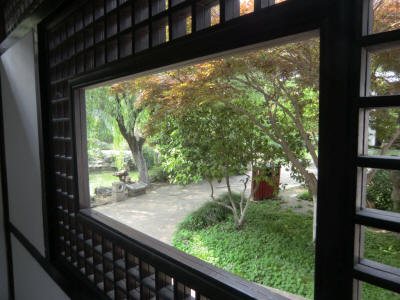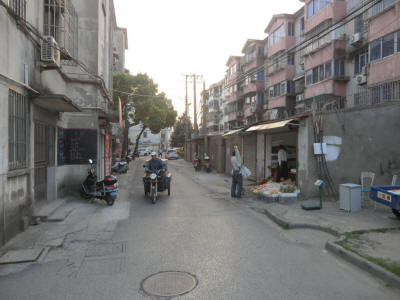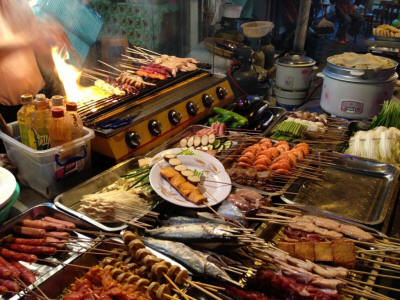Chángshú 常熟
Changshu is a small city some 100 km northwest of Shanghai and some 60 km
north of Suzhou. "Small city" means that it has just 1·5 million inhabitants,
which is tiny compared to the more than 30 million people in its vicinity, such
as its neighbours Suzhou (about 4·5 million) and Shanghai (26 million).
On the outskirts, Changshu looks like any modern Chinese city with its
soulless high-rises and wide roads. Changshu lies in the alluvial plain of the
Yangtze River, so the landscape around it is rather flat and uninspiring.
However, the area is very fertile (the name of the city can be translated as
"eternal harvest") and features many canals and smaller waterways.
The old town of Changshu is almost completely surrounded by a canal,
except for the northwest, where the Yúshān Mountain 虞山 cuts into the circle,
where the canal is replaced by what looks like a small version of the great
wall. Inside this circle, there are no buildings higher than four or five
floors, and in the very centre there are still some old alleys next to small
canals.
Changshu has several nice parks, the most famous one is the Fangta Park which
is named after the Fāngtǎ 方塔 (lit. "square tower") pagoda in its centre. Another
nice park with a small lake and hidden gardens is at the foot of the Yushan
Mountain.
While I was living in Changshu a few years ago, the easiest way to get there
from Shanghai was to take a bus from the bus station next to the Shanghai
Railway Station (look for 长途汽车站 - chángtú qìchē zhàn - long-distance bus
station), the ride was about 90 minutes, the buses ran every half hour or so.
Since then Changshu has gotten a highspeed railway station, so things will have
changed
I lived in Changshu for almost 1½ years, and I have explored almost
every old street and alley on foot or by bicycle. Like any other Chinese city,
there are public bicycle stations everywhere. All you need is a card, and as
long as the bicycle is returned to any station within an hour, it is free (may
have changed, too... it's been a few years).
Below I show some impressions from the inner city:
 |
Here you can easily see the layout of the ancient city centre, which
is surrounded by a circular canal, except for the portion where the
Yushan mountain cuts into the circle. On the mountain, the circle is
completed by a city wall which looks like a miniature version of the
Great Wall.
Inside the circle, next to the easternmost section of the
canal, you can see a rectangular green space, that is the Fangta park
around the pagoda. |
 |
A landmark of Changshu is the Fangta 方塔 which simply translates to
"Square Tower". It was built in 1130 during the Southern Song Dynasty. |
 |
More impressions of the Fangta Park. If one circles it outside, it
doesn't seem very big, but if you enter it, after every corner you will
discover a new sight: A pond, a building, a small garden, a stele, a
bridge - it takes more time than expected to discover all that there is
to see.
Inside the park there is also a tea house where you can
sit down and relax. I often used to have a tea and do my Chinese
homework there. |
 |
More impressions inside the Fangta Park. |
 |
More impressions inside the Fangta Park. |
 |
This is the Yushan park in autumn. Yushan park is at the foot of the
Yushan mountain right next to the ancient inner city. |
 |
Also at the foot of Yushan there are a number of tea houses. |
 |
Looking south from the southern end of the city wall. Behind the
West Gate (西门 Xīmén) there is the continuation of the circular canal
protecting the ancient inner city. |
 |
On Hédōng Jiē 河东街 looking north along the canal running from near
Fangta Park to near the North Gate. |
 |
Same canal a little to the south. |
 |
Bridge crossing the eastern part of the circular canal. |
 |
Another small canal in the south of the ancient centre. As Changshu
lies in the alluvial plain of the Yangtze, there are wetlands and canals
everywhere. |
 |
Alleys in the centre, not far from the place where I lived. |
 |
Just south of the eastern end of the Fangta pedestrian
zone (Fāngtǎ bùxíngjiē 方塔步行街) there is a small square with many small eateries and roadside
BBQs. |
 |
I often went to this one for dinner. As you can have a look and
smell of the food before it is cooked, and also this one doesn't use
cooking oil (you never know what kind of oil they use). I never had any
problems and the food was always delicious. I miss that place. |
 |
Again a view of the small canal along Hedong Street: This café
doesn't only have good coffee but also nice cake. |
 |
A view of the pedestrian
zone (Fāngtǎ bùxíngjiē 方塔步行街). |
 |
Whenever I returned to the Mainland, I had to get a proof of
residence from my landlord and then re-register at the police station.
That sounds more cumbersome than it actually was: The registration
itself took some five minutes, but then I always ran into the guard, who
was a proud Changshunese. As soon as he had found out that I love his
hometown, he never let me go without some longer chat. |
 |
Fertile wetlands just outside of the city limits. The name of the
city 常熟 Chángshú can be translated to something like "frequent harvest". |
 |
In China, 广场舞 Guǎngchǎng Wǔ "square dancing" means just that:
dancing on a square. It is a pastime which in the evening you can see
everywhere in China, it is mainly middle-aged and older women, but also
younger people and men dance, and it is not only Chinese dances.
Several years ago in 哈尔滨 Hā'ěrbīn (Harbin, a city in the northeast of
China) I have seen hundreds of couples waltzing. |
 |
This is the 三环快速路 Sānhuán Kuàisù Lù (3rd ring expressway) around
Changshu. Construction began just before I left in 2014, and has been completed
about two years later. In the meantime, Changshu also has
received a new highspeed railway station.
As comparison to how we
do things in Germany, construction of the new capital airport of Berlin
began in 2006, the opening was planned for October 2011. The final
opening was then in 2020... |





















 home
home China
index
China
index email
email Chinese
culture
Chinese
culture